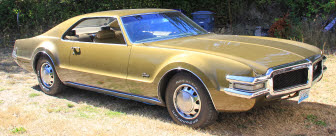Aftermarket rear air shocks
-
Hasty
- Posts: 28
- Joined: Mon Mar 08, 2010 3:09 am
- TOA Membership Number: 765
- Years Owned: 1970 Toronado GT
Aftermarket rear air shocks
Anyone add aftermarket rear air shocks to to a Gen 1 Toro, to assist the tired leaf spring? Just wondering what works out and what doesn't.
St. Cloud, MN
1970 Toronado GT
TOA #765
1970 Toronado GT
TOA #765
- xgecko
- Posts: 454
- Joined: Wed Oct 13, 2010 9:21 pm
- TOA Membership Number: 831
- Years Owned: My first Toronado was a 1968 W-34 with the bucket seats and center console... (weeps gently) It was a New England rustbucket in 1982 after less than 14 years. So sad. But it is what infected me and before I knew it I had another '68, a '69, a '70 and eventually inherited a friend's '67 and another friends '73. After buying my brand new Grand Prix in 1988 I retired the last of my Toronados and pulled the 455 I had rebuilt along the way and put it into storage in a friend's barn where it is to this day.
In Mid September of 2010 I happened to see a repeat of the show where Jay Leno did his 66 Toronado and had an instant remission of the disease which resulted in my purchase of a 1969 in very good condition. I am now in the process of fully rehabilitating it and hope to have it on the road in the spring of 2011. - Location: Gig Harbor, WA
Re: Aftermarket rear air shocks
You actually ask a question that very strongly relates to my question about the rear leafs - how, exactly, does one know they are tired? I just looked into it and unless they are literally bent in the case of our leaf springs or are otherwise damaged they should be just fine. Bushings are a different story as are of course shocks.
That said, I do often wonder what the natural shape of the Toro spring is since this would clearly indicate a tired spring if the spring in the car was not the same shape under load. Springs do not normally lose thier heat treatment and that is what gives them their spring, so it seems reasonable that a spring that is not deformed improperly and is otherwise in good condition should be fine.
I still want to replace mine even knowing that...
That said, I do often wonder what the natural shape of the Toro spring is since this would clearly indicate a tired spring if the spring in the car was not the same shape under load. Springs do not normally lose thier heat treatment and that is what gives them their spring, so it seems reasonable that a spring that is not deformed improperly and is otherwise in good condition should be fine.
I still want to replace mine even knowing that...
I have my Fuel Injected Toronado. Life is good! 


Who is online
Users browsing this forum: No registered users and 9 guests